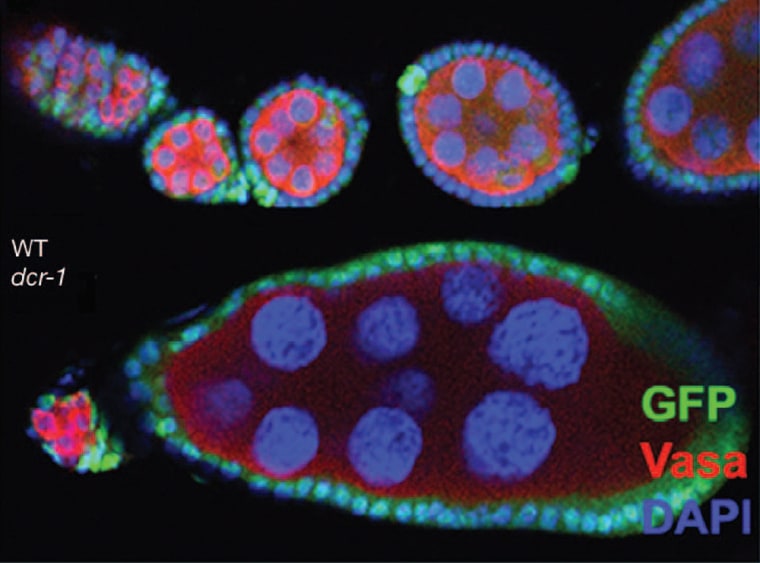One of the medical marvels of stem cells is that they continue to divide and renew themselves when other cells would quit. But what is it that gives stem cells this kind of immortality?
Researchers report in the journal Nature that microRNAs — tiny snippets of genetic material that have now been linked to growth regulation in normal cells as well as cancer growth in abnormal cells — appear to shut off the "stop signals" or brakes that would normally tell cells to stop dividing.
"What we think we see is that there is a special mechanism to get rid of the brakes," said University of Washington biochemist Hannele Ruohola-Baker, a leading member of the research team.
Stem cells have been the focus of intense research interest because of their role in regenerating all the body's tissue types, from blood cells to brain cells. MicroRNAs could conceivably be harnessed to give a boost to aging stem cells, or even add some of the qualities of stem cells to more ordinary types of cells, Ruohola-Baker told MSNBC.com.
Link to cancer
Too much of the wrong kinds of microRNAs could be a bad thing: In fact, three other studies in Thursday's issue of Nature linked certain combinations of microRNAs to cancer:
- One team of researchers reported that a cluster of microRNAs in mice, and was also apparently linked to a variety of human tumors.
- Another found that with a gene known as c-Myc that is already known to cause human cancers.
- The third team found that different human cancers have — suggesting that doctors might someday use microRNA profiles to diagnose human tumors.
In a commentary, Dr. Paul Meltzer of the National Human Genome Research Institute said microRNAs "are now definitely linked to the development of cancer." But one of the researchers involved in the c-Myc study, Dr. Chi Dang of the Johns Hopkins Kimmel Cancer Center, emphasized that microRNAs can have a beneficial as well as a detrimental effect on cell function.
"Whether too much or too little of these or other microRNAs is a good thing or a bad thing — whether it would contribute to or help prevent cancer — depends on their targets in the cell," he said in a Johns Hopkins news release.
Nature distributed the study on microRNAs and stem cells online on Wednesday in advance of next week's print publication, in part to mesh with the three cancer studies.
"For a long time, stem cells and cancer cells have been compared," Ruohola-Baker said. "They are similar in that they don't listen to the 'stop signals.' ... I would imagine that the next two years are going to be very exciting trying to analyze this."
How microRNAs work
In a cell's molecular machinery, strands of ribonucleic acid, or RNA, help turn the genetic code contained in DNA's double helix into instructions for making the proteins needed by the cell. MicroRNAs are short bits of RNA that are thought to act as control dials for the machinery. About 200 human microRNAs have been identified, but researchers are still trying to figure out exactly what they do.
"Nine years ago, we knew nothing about microRNAs," Ruohola-Baker said. "It is a system that is totally against the conventional dogma of biology. They are made to stop other RNA from making proteins."
Ruohola-Baker's research focuses on fruit flies, which have about 80 types of microRNA. She and her colleagues from the University of Washington and Northwestern University genetically modified female fruit flies so that their ovaries produced normal stem cells as well as stem cells in which the microRNAs were deactivated. Then they compared how many egg chambers were produced by each type of stem cells.
The results showed a falling egg production rate over the course of eight to 12 days, and the researchers determined that was because the mutant stem cells were no longer dividing.
The stem cells didn't transform themselves into different types of cells, Ruohola-Baker said: "They kept their 'stem-cellness.' The only thing that was wrong is that they did not divide."
The researchers concluded that when the microRNAs were knocked out of commission, the stem cells obeyed the same stop signal that kept other types of cells from proliferating. Their experiments indicated that a protein called Dacapo — the fruit fly's equivalent of a human tumor suppressor — served as the stop signal.
But exactly which of the fruit fly's 80 microRNAs is responsible for short-circuiting the stop signal and keeping stem cells dividing? That's one of the questions Ruohola-Baker and her colleagues plan to address next. Ruohola-Baker said they'll focus first on five likely suspects that were identified through computer simulations of the cell's chemical interactions.
Help for aging stem cells?
And now that the researchers have found that too few microRNAs are bad for stem cells, they want to see what an abundance of microRNAs will do. Perhaps the right recipe can give even ordinary cells a touch of "stem-cellness."
"We are right now testing that, by overproducing microRNAs in the daughter cells that have begun to differentiate," Ruohola-Baker said. "Maybe this would also help aging stem cells. Maybe you can keep them dividing by using more microRNAs."
Ruohola-Baker's colleagues on the research team are Steve Hatfield, Halyna Shcherbata and Karin Fischer of the University of Washington; and Richard Carthew and Kenji Nakahara of Northwestern University.
